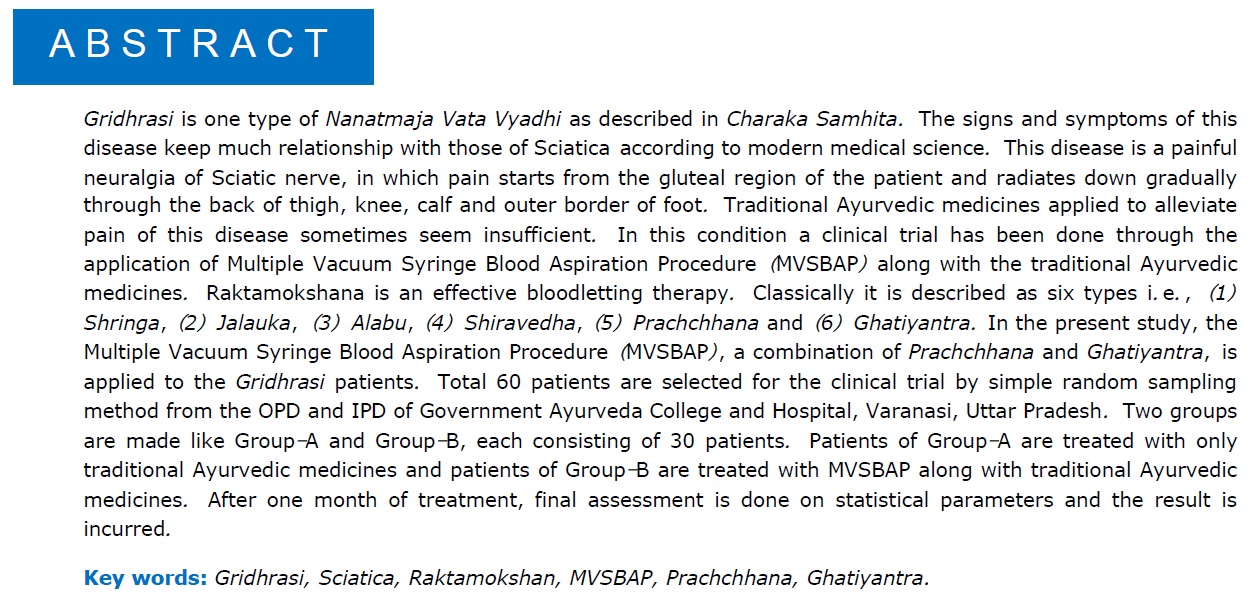Clinical study of Raktamokshana procedure in the disease Gridhrasi
Keywords:
Gridhrasi, Sciatica, Raktamokshan, MVSBAP, Prachchhana, Ghatiyantra.Abstract
Gridhrasi is one type of Nanatmaja Vata Vyadhi as described in Charaka Samhita. The signs and symptoms of this disease keep much relationship with those of Sciatica according to modern medical science. This disease is a painful neuralgia of Sciatic nerve, in which pain starts from the gluteal region of the patient and radiates down gradually through the back of thigh, knee, calf and outer border of foot. Traditional Ayurvedic medicines applied to alleviate pain of this disease sometimes seem insufficient. In this condition a clinical trial has been done through the application of Multiple Vacuum Syringe Blood Aspiration Procedure (MVSBAP) along with the traditional Ayurvedic medicines. Raktamokshana is an effective bloodletting therapy. Classically it is described as six types i.e., (1) Shringa, (2) Jalauka, (3) Alabu, (4) Shiravedha, (5) Prachchhana and (6) Ghatiyantra. In the present study, the Multiple Vacuum Syringe Blood Aspiration Procedure (MVSBAP), a combination of Prachchhana and Ghatiyantra, is applied to the Gridhrasi patients. Total 60 patients are selected for the clinical trial by simple random sampling method from the OPD and IPD of Government Ayurveda College and Hospital, Varanasi, Uttar Pradesh. Two groups are made like Group-A and Group-B, each consisting of 30 patients. Patients of Group-A are treated with only traditional Ayurvedic medicines and patients of Group-B are treated with MVSBAP along with traditional Ayurvedic medicines. After one month of treatment, final assessment is done on statistical parameters and the result is incurred.
Downloads
References
Charak Samhitsa, Introduction by Padmabhusana Vaidya Sri Satyanarayan Shastri with elaborated Vidyotini Hindi Commentary by Pt. Kashinath Shastri and Dr. Gorakhanatha Chaturvedi. Published by Chaukhambha Bharati Academy, Varanasi. Twelfth Edition 1984. Both Purvardha and Uttarardha.
Sushruta Samhita, Edited with Ayurveda Tatva Sandipika. Hindi Commentary, Notes etc. by Kaviraja Ambikadutta Shastri and Foreword by Dr. Pranajivana Manekchanda Mehta. Published by Chaukhambha Sanskrit Sansthan, Varanasi. Seventh Edition 1989. Both Part-I and Part-II.
Astanga Hridayam, Edited with the Vidyotini Hindi commentary by Kaviraja Atrideva Gupta. Edited by Vaidya Yadunandana Upadhyaya. Published by Chaukhambha Sanskrit Sansthan, Varanasi. Eleventh Edition 1993.
Chakradatta, With Vidyotini Hindi Commentary by Dr. Indradev Tripathi. Editor Prof. Ramanath Dwivedy. Published by Chaukhambha Sanskrit Santhan, Varanasi. Fourth Edition 2002.
Madhav Nidan, With the Madhukosha Sanskrit commentary by Sri Vijayarakshita and Srikanthadatta. Vidyotini Hindi commentary and Notes by Sri Sudarshan Shastri and Revised & edited by Prof. Yadunandana Upadhyaya. Seventeenth Edition 1987. Published by Chaukhambha Sanskrit Pratisthan, Varanasi. Both Part-I and Part-II.
Abhinava Chintamani of Mahamati Bhagawan Chakrapani Das, Editor-in-Chief Prof. G. S. Lavekar. Hindi Commentary by Acharya Tarachand Sharma. Published by Central Council for Research in Ayurveda and Siddha, New Delhi. Both Part-I and Part-II. First Publication in 2009.
Sarangadhara Samhita, Translated into English by Prof. K. R. Srikanta Murthy. Published by Chaukhambha Orientalia, Varanasi. Reprint Edition 2009.
Yogaratnakar, With Vidyotini Hindi Commentary by Vaidya Laxmipati Shastri and Edited by Bhisagratna Shribrahmashankar Shastri. Published by Chaukhambha Prakashan. Reprinted 2005.
Introduction to Kayachikitsa, By C. Dwarakanatha. Published by Chaukhambha Orientalia, Varanasi. Third Edition 1996.
Advances in Research in Indian Medicine, Edited by K. N. Udupa, G. N. Chaturvedi and S. N. Tripathi. Published by Banaras Hindu University, Varanasi in 1970.
Ayrvediya Panchakarma Vigyan, Written by Vaidya Haridas Sridhar Kasture. Published by Baidyanath Ayurved Bhawan Pvt. Ltd. Third Edition 1985.















